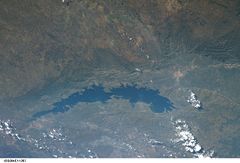Lake Kariba
2008/9 Schools Wikipedia Selection. Related subjects: African Geography
| Lake Kariba | |
|---|---|
| Coordinates | |
| Lake type | Hydroelectric reservoir |
| Catchment area | 663,000 km² |
| Basin countries | Zimbabwe Zambia |
| Max. length | 220 km |
| Max. width | 40 km |
| Surface area | 5,400 km² |
| Average depth | 31 m |
| Max. depth | 78 m |
| Water volume | 160 km³ |
| Surface elevation | 485 m |
| Islands | Chete Island Sekula Chikanka. |
Lake Kariba is a large, man-made lake and reservoir located on the Zambezi river, about halfway between the river's source and mouth, about 1300 kilometers upstream from the Indian Ocean. The lake lies along the border between Zambia and Zimbabwe. Lake Kariba was filled between 1958 and 1963 following the completion of the Kariba Dam at its northeastern end, flooding the Kariba Gorge on the Zambezi River and displacing large numbers of the local Tonga people.
The Zimbabwean town of Kariba was built for construction workers on the lake's dam, while some other settlements such as Milbibezi in Zimbabwe and Siavonga and Sinazongwe in Zambia have grown up to house people displaced by the rising waters.
Physical characteristics
Lake Kariba is over 220 kilometers (140 mi) long and up to 40 kilometers (20 mi) in width. It covers an area of 5,580 square kilometers (2,150 sq mi) and its storage capacity is an immense 185 cubic kilometers (44.4 cu mi). The mean depth of the lake is 29 meters (95 ft); the maximum depth is 97 meters (320 ft). It is one of the world's largest man-made reservoirs. The enormous mass of water (approximately 180,000,000,000,000 kilograms, or 180 petagrams [200 billion tons]) is believed to have caused induced seismicity in the seismically active region, including over 20 earthquakes of greater than 5 magnitude on the Richter scale.
The lake is home to several islands, including Chete Island, Sekula and Chikanka.
Ecology
Before Lake Kariba was filled, the existing vegetation was burned, creating a thick layer of fertile soil on land that would become the lake bed. As a result the ecology of Lake Kariba is vibrant. A number of fish species have been introduced to the lake, notably the sardine-like kapenta (transported from Lake Tanganyika), which now supports a thriving commercial fishery. Other inhabitants of Lake Kariba include Nile crocodiles and hippopotamuses.
Gamefish, particularly Tigerfish, which was among the indigenous species of the Zambezi river system, now thrive on the kapenta, which in turn encourage tourism. Both Zambia and Zimbabwe are now attempting to develop the tourism industry along their respective coasts of Lake Kariba.
Fish eagles, cormorants and other water birds patrol the shorelines, as do occasional herds of elephants.
Protected Areas
The portion of Lake Kariba which falls within Zimbabwe has been designated a Recreational Park within the Zimbabwe Parks and Wildlife Management system.
In popular culture
Lake Kariba and the Kariba Dam provide the setting for roughly 300 pages of the L. Ron Hubbard science fiction novel Battlefield Earth, which in 2000 was adapted into a film of the same name. The novel itself was a bestseller, however the film adaptation was very poorly received.
